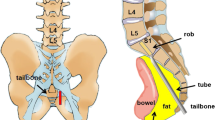Abstract
Background
Sacropelvic fixation (SPF) is an integral part of ASD surgery. Literature suggests that combination of S1 and iliac screws may be associated with lowest rate of complications.
Aim
To analyze the rate and potential factors of mechanical failure associated with SPF in adult spinal deformity surgery.
Materials and methods
Of 504 patients enrolled in a prospective multicentric database, 239 were treated conservatively and 265 were treated surgically. Forty-five of those who had sacroiliac fixations and with >6 months (or to failure) f/up constitute the population. Type of iliac fixation was S2 alar/iliac (S2AI) screws in 20 (44.4 %) and iliac screws with lateral connectors (IwL) in 25 (55.6 %). Diagnoses were degenerative in 20, failed back in 11 and other in 14. Average instrumentation length was 11.6 ± 4.0 levels. Cases with failure were compared to those without using Fisher’s Exact and Mann–Whitney U tests.
Results
A total of 16 implant related complications were identified (35.6 %). Failures were identified on an average of 224.1 days (8–709) following index surgery. Failure rate of S2AI screws was 35 vs. 12 % for IwL screws (p > 0.05). All broken screws were associated with S2AI technique with polyaxial screws. Comparison of failed cases to others revealed that failed cases had inadequate restoration of Lumbar Lordosis but this was not statistically insignificant. Only age was a significantly different, patient with failure being older.
Discussion
Pelvic fixation is still associated with a very high rate of mechanical failure. Major risk factors appear to be age and type of fixation. Although could not be shown to be statistically significant, failure to restore the optimal sagittal balance may be a contributing factor as well. So in conclusion, in cases with suboptimal sagittal plane correction, S2AI with polyaxial screws seem to have higher risk of short-term acute failure compared to IwL.


Similar content being viewed by others
References
Kim YJ, Bridwell KH, Lenke LG, Rhim S, Cheh G (2006) Pseudarthrosis in long adult spinal deformity instrumentation and fusion to the sacrum: prevalence and risk factor analysis of 144 cases. Spine 31(20):2329–2336
Moshirfar A, Rand FF, Sponseller PD, Parazin SJ, Khanna AJ, Kebaish KM, Stinson JT, Riley LH 3rd (2005) Pelvic fixation in spine surgery. Historical overview, indications, biomechanical relevance, and current techniques. J Bone Joint Surg Am 87(2):89–106
Shen FH, Mason JR, Shimer AL, Arlet VM (2013) Pelvic fixation for adult scoliosis. Eur Spine J 22(Suppl 2):S265–S275
Devlin VJ, Boachie-Adjei O, Bradford DS, Ogilvie JW, Transfeldt EE (1991) Treatment of adult spinal deformity with fusion to the sacrum using CD instrumentation. J Spinal Disord 4(1):1–14
Schwend RM, Sluyters R, Najdzionek J (2003) The pylon concept of pelvic anchorage for spinal instrumentation in the human cadaver. Spine 28(6):542–547
Lebwohl NH, Cunningham BW, Dmitriev A, Shimamoto N, Gooch L, Devlin V, Adjei OB, Wagner TA (2002) Biomechanical comparison of lumbosacral fixation techniques in a calf spine model. Spine 27(21):2312–2320
Kebaish KM (2010) Sacropelvic fixation: techniques and complications. Spine 35(25):2245–2251
Tsuchiya K, Bridwell KH, Kuklo TR, Lenke LG, Baldus C (2006) Minimum 5-year analysis of L5–S1 fusion using sacropelvic fixation (bilateral S1 and iliac screws) for spinal deformity. Spine 31(3):303–308
Kuklo TR, Bridwell KH, Lewis SJ, Baldus C, Blanke K, Iffrig TM, Lenke LG (2001) Minimum two-year analysis of sacropelvic fixation and L5–S1 fusion utilizing S1 and iliac screws. Spine 26(18):1976–1983
Saer EH 3rd, Winter RB, Lonstein JE (1990) Long scoliosis fusion to the sacrum in adults with nonparalytic scoliosis. An improved method. Spine 15(7):650–653
Emami A, Deviren V, Berven S, Smith JA, Hu SS, Bradford DS (2002) Outcome and complications of long fusion to the sacrum in adult spine deformity: Luque–Galveston, combined iliac and sacral screws, and sacral fixation. Spine 27(7):776–786
Pellise F, Domingo-Sabat M, Alanay A, Bago J, VilaCasedemunt A, Villanueva C, Acaroglu E, European Spine Study Group (2012) Impact of radiographic parameters on hrqol in adult spinal deformity- the ‘lordosis gap’ better than lumbar lordosis? Paper # 19 Spineweek. Scientific program abstract book, pp 12
Pateder DB, Park YS, Kebaish KM, Cascio BM, Buchowski JM, Song EW, Shapiro MB, Kostuik JP (2006) Spinal fusion after revision surgery for pseudarthrosis in adult scoliosis. Spine 31(11):E314–E319
Allen BL Jr, Ferguson RL (1984) The Galveston technique of pelvic fixation with L-rod instrumentation of the spine. Spine 9(4):388–394
Cunningham BW, Lewis SJ, Long J, Dmitriev AE, Linville DA, Bridwell KH (2002) Biomechanical evaluation of lumbosacral reconstruction techniques for spondylolisthesis: an in vitro porcine model. Spine 27(21):2321–2327
Kostuik JP (1988) Treatment of scoliosis in the adult thoracolumbar spine with special reference to fusion to the sacrum. Orthop Clin North Am 19:371–381
Standard specification and test methods for metallic medical bone screws: ASTM-Designation: F543–13 standarts (www.astm.org)
Yu BS, Li ZM, Zhou ZY, Zeng LW, Wang LB, Zheng ZM, Lu WW (2011) Biomechanical effects of insertion location and bone cement augmentation on the anchoring strength of iliac screw. Clin Biomech (Bristol, Avon) 26(6):556–561
Zheng ZM, Zhang KB, Zhang JF, Yu BS, Liu H, Zhuang XM (2009) The effect of screw length and bone cement augmentation on the fixation strength of iliac screws: a biomechanical study. J Spinal Disord Tech 22(8):545–550
Acknowledgement
This study and the European Spine Study Group are sponsored by a research grant from Depuy Spine Inc.
Conflict of interest
None.
Author information
Authors and Affiliations
Consortia
Corresponding author
Rights and permissions
About this article
Cite this article
Guler, U.O., Cetin, E., Yaman, O. et al. Sacropelvic fixation in adult spinal deformity (ASD); a very high rate of mechanical failure. Eur Spine J 24, 1085–1091 (2015). https://doi.org/10.1007/s00586-014-3615-1
Received:
Revised:
Accepted:
Published:
Issue Date:
DOI: https://doi.org/10.1007/s00586-014-3615-1




